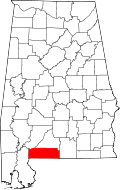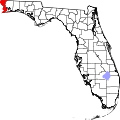Poarch Creek Indian Reservation | |
|---|---|
 Location of the Poarch Creek Indian Reservation | |
| Tribe | Poarch Band of Creek Indians |
| Country | United States |
| State | Alabama |
| Area | |
• Total | 0.93 km2 (0.36 sq mi) |
| Website | Poarch Band of Creek Indians |
The Poarch Creek Indian Reservation is a Creek Indian reservation in the state of Alabama. It is the home of the Poarch Band of Creek Indians, the only federally recognized Native American tribe in the state.
Contents
The reservation is located entirely within Escambia County, eight miles (13 km) northwest of Atmore. Of the Poarch Band's 2,340 members, about 1,000 lived on or near the 230-acre (0.93 km2) reservation as of 2006. [1] The Poarch Band also holds other trust lands in Alabama and Florida. [2]




